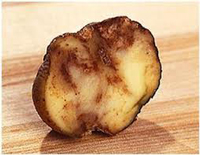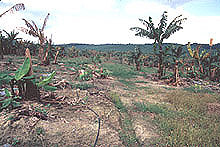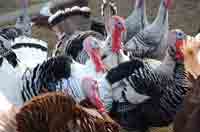Piedmont Heritage Poultry 
Why Raise Heritage Anything?
The short answer: To ensure the foods we eat today are available in the future, by raising the old-fahioned (heritage, heirloom) foods that have large, genetically diverse gene pools. Our commercial foods that we rely on to feed the world's massive population of people, rely on just a few varieties or breeds, which through selection for uniformity for affordable mass production, have lost the genetic diversity to survive outbreaks of disease, pest, or weather disasters.
The long answer: When a food system relies on just one or a few commercial varieties, as the world does today, diseases (as well as pests and weather events such as drought or floods) can take on  catastrophic, epidemic proportions. The Irish potato famine of the 1840's is a good example. The Irish relied on only one variety ("breed" in livestock terms) of potato. A single disease-causing organism was able to wipe out almost the entire crop, with devastating effects on those who were dependent upon potatoes as the main food in their diet (a million died of starvation). We still have potatoes today, because other potato varieties with genes resistant to that potato blight were still being raised elsewhere. (Picture at right shows a potato ruined by the potato blight that struck Ireland.)
catastrophic, epidemic proportions. The Irish potato famine of the 1840's is a good example. The Irish relied on only one variety ("breed" in livestock terms) of potato. A single disease-causing organism was able to wipe out almost the entire crop, with devastating effects on those who were dependent upon potatoes as the main food in their diet (a million died of starvation). We still have potatoes today, because other potato varieties with genes resistant to that potato blight were still being raised elsewhere. (Picture at right shows a potato ruined by the potato blight that struck Ireland.)
Consider the banana. In the 1950's the commercial banana industry was based in Central and South America and relied on one variety, Gros Michel. Along came Panama Disease, a fungus that wiped out almost all banana plantations in Central and South America and threatened to make the banana industry extinct until a disease resistant variety, the Cavendish, was found. With the Cavendish, the commercial banana industry recovered and expanded worldwide to other continents. Unfortunately, the Cavendish turned out to be particularly susceptible to a new strain of Panama Disease that popped up in  the 1990's in Southeast Asia. The disease is rapidly spreading globally. It has already wiped out thousands of hectares of Cavendish trees in Southeast Asia and is on the rise in Africa and Australia. It is only a matter of time before it will, inevitably, reach South America. Once again the banana's future in the grocery store is in jeopardy. (Picture at left shows a Cavendish banana plantation devastated by the newPanama Disease strain in 1995.)
the 1990's in Southeast Asia. The disease is rapidly spreading globally. It has already wiped out thousands of hectares of Cavendish trees in Southeast Asia and is on the rise in Africa and Australia. It is only a matter of time before it will, inevitably, reach South America. Once again the banana's future in the grocery store is in jeopardy. (Picture at left shows a Cavendish banana plantation devastated by the newPanama Disease strain in 1995.)
Turn now to livestock. In the U.S. only a few main breeds dominate the four footed livestock industry, and the poultry industry is particularly vulnerable. Chickens on modern commercial production lines are missing at least half of the genetic diversity their ancestors once had, making them more vulnerable to diseases or non-optimal growing conditions. That genetic diversity was lost in the 1950's with development of wide-scale commercial production. Losing half your genetic pool can mean you don't have enough variation for some individuals to survive when disease or adverse growing conditions strike.
Take a closer look at turkeys. A whopping 99% of all turkeys raised in the U.S. are the Broad-breasted White. A single breed of turkey is no different than a single variety of plant. If a disease pops up to which that breed is susceptible, the commercial turkey population would be wiped out. Without people raising the old heritage breeds of turkeys to preserve genetic diversity, the grocery store turkey could disappear.
Is this an attack on commercial production? Definitely not! We need both. We need commercial high volume production to be able to feed the world's exponentially growing population, but we also need to preserve the old (heritage or heirloom) foods. When commercial foods fall victim to pests, drought or other adverse weather conditions, or disease epidemics, you're going to need to find resistant genes in the old, highly biodiverse animal breeds and plant varieties to be able to develop new commercial production foods. This is true, whether accomplished through natural cross breeding or the highly debated, high tech GMO gene splicing technques. Regardless of which methods will stand the test of time, in the meantime, we need to keep our diminishing resource of diverse genetic material alive.
Enter the heritage food farmer--someone who is working hard to ensure that the kinds of food you eat today are still available tomorrow. But there are not enough heritage food farmers and we are losing diversity in our food sources. Currently 1,500 farm animal breeds are in danger of becoming extinct. We have lost 160  worldwide in the past fifteen years, 60 of those in just the last five years. That's genetic variation lost forever. (Picture at left shows a flock of heritage turkeys.) We are losing breeds, because farming is a business. And to stay in business, farmers must sell what they produce in order stay in business. You can't just raise a chicken and set it on the shelf for the "some day" it might be needed. You have to raise a new chicken every year--and sell it to stay in business. But if people won't buy what the farmer produces, the farmer can't afford to continue to produce it, even with the best of intentions.
worldwide in the past fifteen years, 60 of those in just the last five years. That's genetic variation lost forever. (Picture at left shows a flock of heritage turkeys.) We are losing breeds, because farming is a business. And to stay in business, farmers must sell what they produce in order stay in business. You can't just raise a chicken and set it on the shelf for the "some day" it might be needed. You have to raise a new chicken every year--and sell it to stay in business. But if people won't buy what the farmer produces, the farmer can't afford to continue to produce it, even with the best of intentions.
Unfortunately heritage and heirloom foods usually can't compete in cost with high volume commercial breeds or varieties, because of traits such as lower yields, slower growth rates, longer times to reach maturity for market, and shorter shelf life. This means higher production cost in terms of such things as increased labor and feed. For example, a commercial turkey is slaughtered at only 16-18 weeks of age, but heritage turkeys require 26-28 weeks or more to reach harvest weight.
There are trade-offs, however. Heritage and heirloom foods are usually much tastier than commercial production foods. Emphasis on flavor has NOT been sacrificed to the higher commercial priorities of selecting traits for such things as "shipability" (a product tough enough not to become damaged during shipment), shelf life, uniform harvest dates, and uniform product size for mechanized harvesting and processing. Also, heritage and heirloom foods are non-GMO, and most are raised sustainably. Many are also certified organic. And they usually can be found locally, which greatly reduces the carbon footprint (e.g., use of petroleum products in growing and shipment) and increases freshness.
Add "heritage" or "heirloom" to your shopping list now and then! Support the heritage food farmers near you. Even if you are on a tight budget, buy the results of their efforts a time or two each year. And this is not just the packaged food ready to be prepared at home! It's also seeds, plants, and live animals. If you want to keep poultry in your backyard, have your own vegetable garden, or keep livestock for your own consumption, include a heritage breed or heirloom variety to raise among your choices! This type of support keeps the heritage farmer in business and ensures we retain genetic diversity for our foodstuffs, so your favorite foods will continue to appear at supermarkets and farmers' markets now and for future generations.
Updated 2 January 2024